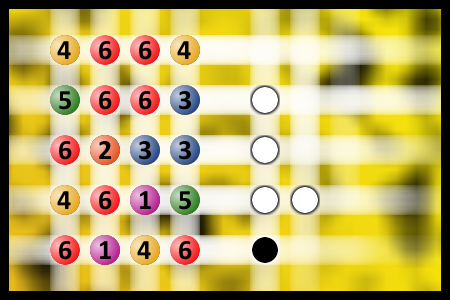Which is a winning combination of digits?
The computer chose a secret code (sequence of 4 digits from 1 to 6). Your goal is to find that code. Black circles indicate the number of hits on the right spot. White circles indicate the number of hits on the wrong spot.
Bloody Brilliant Dracula Jokes for World Dracula Day
May 26th is World Dracula Day—sink your teeth into these bloody good jokes that’ll leave you howling with laughter (just not under a full moon)!
I work in a factory that makes Dracula figurines.
However, there are only 2 employees so I have to make every second count.
🧛🏻🧛🏻🧛🏻🧛🏻🧛🏻
I heard Dracula has started selling NSFW content...
He's started an OnlyFangs.
🧛🏻🧛🏻🧛🏻🧛🏻🧛🏻
Why was Dracula a bad CEO?
He was always avoiding the stakeholders.
🧛🏻🧛🏻🧛🏻🧛🏻🧛🏻
3 vampires are having a competition to prove who's the most vicious vampire amongst them.
The strongest one started 1st,
"watch this," He said as he flies so fast, about 100 miles/hour. After only 10 minutes, he comes back with blood all over his mouth. "what happened?" they asked. "did you see that house over there?" "yes?" "well.. I killed the entire family and sucked the blood dry!" "wow!? fascinating, as expected from the strongest vampire"
Then the eldest one takes the next turn "watch and learn," he said as he flies even faster, about 120 miles/hour. After only 5 minutes, he comes back with blood all over his mouth and his neck. "what happened??" they asked. "did you see that village over there?" "ye..yes?" "well.. I killed every last person on that village and sucked the blood dry!" "wow!? magnificent! truly amazing, we can expect no less from the eldest one!"
Finally the last turn belongs to the fastest one, "don't blink or you'll miss it" he said as he flies really fast, even faster than the other two, about 140 miles/hour. After only a mere 30 seconds, he comes back with blood all over his mouth, his neck, and his nose. "wh..what happened???" they asked. "did you see that big ass tree over there?" "ye..yes?!" "well.. I didn't"
🧛🏻🧛🏻🧛🏻🧛🏻🧛🏻
2 vampires are sitting at a bar when the bartender asks the first "what'll be?"
To which the vampire replies "ahh, make it a bloody Mary, and double up on the Mary."
The bartender then turns and asks the second vampire, "What I can do for you?"
The second vampire replies, "I'll just have a cup of hot water"
Both the bartender and the first vampire look at him quizzically, "why do you want hot water?"
He then pulls a used tampon out of his pocket, "oh! I making tea."
🧛🏻🧛🏻🧛🏻🧛🏻🧛🏻
What did one lesbian vampire say to the other?
See you next month!
🧛🏻🧛🏻🧛🏻🧛🏻🧛🏻
My phlebotomist told me a Dracula joke, to calm me down...
I asked if she knew any other jokes in the same vein.
🧛🏻🧛🏻🧛🏻🧛🏻🧛🏻
I went to collect my dracula costume, ready for Halloween. They handed me a Manchester United shirt instead.
I explained, "Sorry, you must have misheard me, I wanted to dress as a COUNT!"
🧛🏻🧛🏻🧛🏻🧛🏻🧛🏻
Dracula was on one of those DIY TV programmes recently.
His castle was getting a revamp.
🧛🏻🧛🏻🧛🏻🧛🏻🧛🏻
I had to end my friendship with Dracula.
He was a pain in the neck.
🧛🏻🧛🏻🧛🏻🧛🏻🧛🏻
Did you know vampires arent real?
Unless you Count Dracula.

